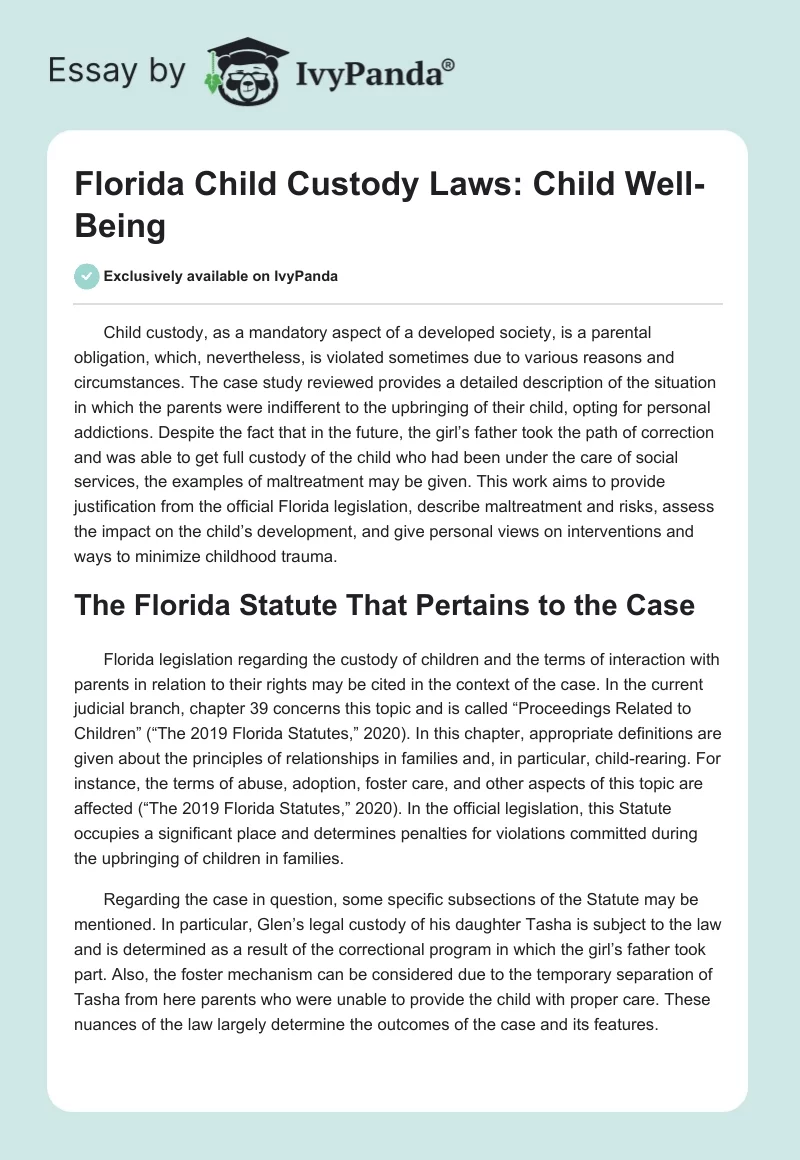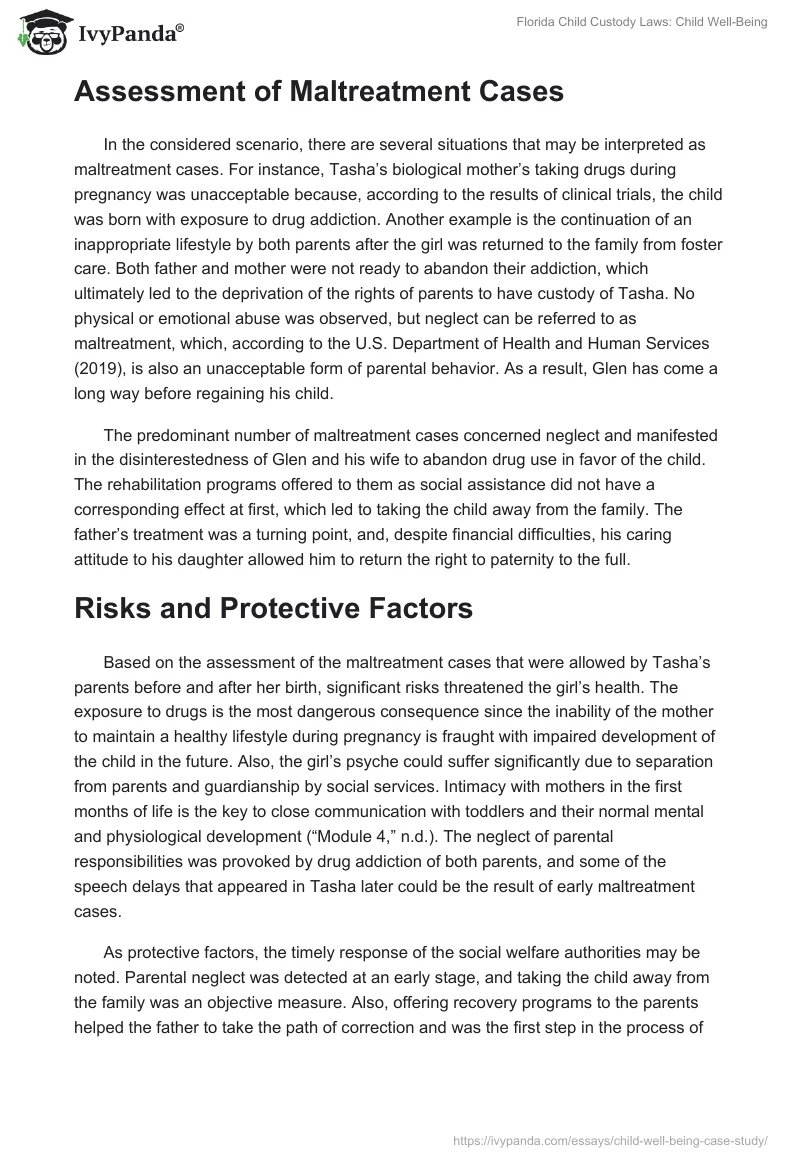Child custody, as a mandatory aspect of a developed society, is a parental obligation, which, nevertheless, is violated sometimes due to various reasons and circumstances. The case study reviewed provides a detailed description of the situation in which the parents were indifferent to the upbringing of their child, opting for personal addictions. Despite the fact that in the future, the girl’s father took the path of correction and was able to get full custody of the child who had been under the care of social services, the examples of maltreatment may be given. This work aims to provide justification from the official Florida legislation, describe maltreatment and risks, assess the impact on the child’s development, and give personal views on interventions and ways to minimize childhood trauma.
The Florida Statute That Pertains to the Case
Florida legislation regarding the custody of children and the terms of interaction with parents in relation to their rights may be cited in the context of the case. In the current judicial branch, chapter 39 concerns this topic and is called “Proceedings Related to Children” (“The 2019 Florida Statutes,” 2020). In this chapter, appropriate definitions are given about the principles of relationships in families and, in particular, child-rearing. For instance, the terms of abuse, adoption, foster care, and other aspects of this topic are affected (“The 2019 Florida Statutes,” 2020). In the official legislation, this Statute occupies a significant place and determines penalties for violations committed during the upbringing of children in families.
Regarding the case in question, some specific subsections of the Statute may be mentioned. In particular, Glen’s legal custody of his daughter Tasha is subject to the law and is determined as a result of the correctional program in which the girl’s father took part. Also, the foster mechanism can be considered due to the temporary separation of Tasha from here parents who were unable to provide the child with proper care. These nuances of the law largely determine the outcomes of the case and its features.
Assessment of Maltreatment Cases
In the considered scenario, there are several situations that may be interpreted as maltreatment cases. For instance, Tasha’s biological mother’s taking drugs during pregnancy was unacceptable because, according to the results of clinical trials, the child was born with exposure to drug addiction. Another example is the continuation of an inappropriate lifestyle by both parents after the girl was returned to the family from foster care. Both father and mother were not ready to abandon their addiction, which ultimately led to the deprivation of the rights of parents to have custody of Tasha. No physical or emotional abuse was observed, but neglect can be referred to as maltreatment, which, according to the U.S. Department of Health and Human Services (2019), is also an unacceptable form of parental behavior. As a result, Glen has come a long way before regaining his child.
The predominant number of maltreatment cases concerned neglect and manifested in the disinterestedness of Glen and his wife to abandon drug use in favor of the child. The rehabilitation programs offered to them as social assistance did not have a corresponding effect at first, which led to taking the child away from the family. The father’s treatment was a turning point, and, despite financial difficulties, his caring attitude to his daughter allowed him to return the right to paternity to the full.
Risks and Protective Factors
Based on the assessment of the maltreatment cases that were allowed by Tasha’s parents before and after her birth, significant risks threatened the girl’s health. The exposure to drugs is the most dangerous consequence since the inability of the mother to maintain a healthy lifestyle during pregnancy is fraught with impaired development of the child in the future. Also, the girl’s psyche could suffer significantly due to separation from parents and guardianship by social services. Intimacy with mothers in the first months of life is the key to close communication with toddlers and their normal mental and physiological development (“Module 4,” n.d.). The neglect of parental responsibilities was provoked by drug addiction of both parents, and some of the speech delays that appeared in Tasha later could be the result of early maltreatment cases.
As protective factors, the timely response of the social welfare authorities may be noted. Parental neglect was detected at an early stage, and taking the child away from the family was an objective measure. Also, offering recovery programs to the parents helped the father to take the path of correction and was the first step in the process of his socialization. These measures contributed significantly to the fact that Tasha was brought up by Glen.
Assessment of the Family System
When assessing the family system of the case in question, one can note that the birth of Tasha did not make the marriage of Glen and Denisha a strong union. Despite the biological relationship with her parents, the girl was not attached to them since birth due to the upbringing by the guardianship authorities, and the maltreatment cases allowed were the main drivers for this. From this perspective, the support system may be considered a significant factor that contributed to keeping the child in more favorable conditions.
At the same time, the lifestyle that Glen and Denisha led could have had a severe influence on Tasha since any behavior promoted by adults might become a pattern for the girl in the future. According to the U.S. Department of Health and Human Services (2019), coaching may be offered to different parents so that they could provide comprehensive custody to their children. However, in this case, the family system had many gaps. The lack of emotional connection between the mother and the child affected the upbringing of the girl negatively, and the woman was not ready to take responsibility for her girl. As a result, the paternal role was predominant, and Glen and Tasha began to live in an incomplete but loving family.
Possible Impact of the Abuse on the Child’s Development
When evaluating the impact of the abuse on the child’s development in general, one can note a set of problems that inappropriate conditions of upbringing may entail. In available sources, delays in cognitive functions are mentioned, as well as the issues of emotional development, which can lead to difficulties in social adaptation (“Module 4,” n.d.). Delays in speech development, which are observed in Tasha, may also be a consequence of her parents’ neglect at the early stages of the child’s life.
For a toddler, a calm atmosphere and attention from adults are indispensable conditions for normal growth. Otherwise, a child can grow up to be a person with a range of mental disorders, including challenges in expressing feelings, depression, and other disorders (“Module 4,” n.d.). In general, maltreatment cases make it difficult to resolve such issues at an older age. It is difficult for a child to control his or her habits and realize guilt for misconduct if he or she sees an example of adults who are not involved in parenting (“Module 4,” n.d.). These effects are the most common manifestations of the abuse and neglect allowed by parents.
Assessment of the Interventions
Since Tasha’s parents led an inappropriate lifestyle both before her birth and later, the decision to isolate the child from them was an objective one from the standpoint of preventing harm to her physical and mental health. In turn, the assistance offered to Glen and Denisha was the right decision in view of the possibility of their recovering from drug addiction. The girl had a chance to return to her parents, thereby obtaining an opportunity to grow up in a complete family.
According to the U.S. Department of Health and Human Services (2019), supporting relationships promoted by social services are good practices that help adults recognize mistakes and accept existing problems. As a result, the decision to return Tasha to his father, who went through a complex rehabilitation program, turned out to be correct. The financial assistance provided to Glen at the early stage of his independent life with his daughter helped him to entrust work and housing. In addition, the father realized the importance of interacting with the child and became more attentive to her problems, which, in turn, had a positive effect on the girl’s well-being.
Possible Handling the Case
Since the interventions applied by the guardianship and social support authorities were objective and successful, possible additional solutions could hardly have improved the situation significantly. Nevertheless, in order to make the development of the child more favorable, more attention could have been paid to Denisha, the girl’s mother. Although the woman showed less participation in the daughter’s life than Glen, the possibility of raising the child in a complete family could contribute to Tasha’s more natural mental development.
Another possible measure that could have been effective in preventing childhood trauma was to involve other interested parties. Despite the fact that Glen and Denisha lived with the man’s mother, there is no evidence that the woman influenced her son and daughter-in-law. If social workers had turned to friends and acquaintances of the married couple for help as support, this might have been an additional incentive for the spouses to abandon addiction and start raising their child. However, the outcome of the interventions is much more favorable than what could have happened if the social services had been inactive.
Conclusion
The analysis of the case study under consideration confirms that the measures taken by social services regarding the protection of the child were justified due to the parents’ inability to provide comprehensive care and guardianship. The influence of the abuse and neglect on the development of Tasha could have been significant since the emotional-psychological background is laid at an early age. The family system of Glen and Denisha had a number of gaps, and the allowed maltreatment cases were a strong argument in favor of taking severe measures to isolate the girl from her parents. As additional solutions, engaging other stakeholders and working intensely with Denisha could have been concomitant interventions.
References
The 2019 Florida Statutes. (2020). Web.
Module 4: Trauma and the child. (n.d.). Web.
U.S. Department of Health and Human Services. (2019). 2019/2020 prevention resource guide. Web.


